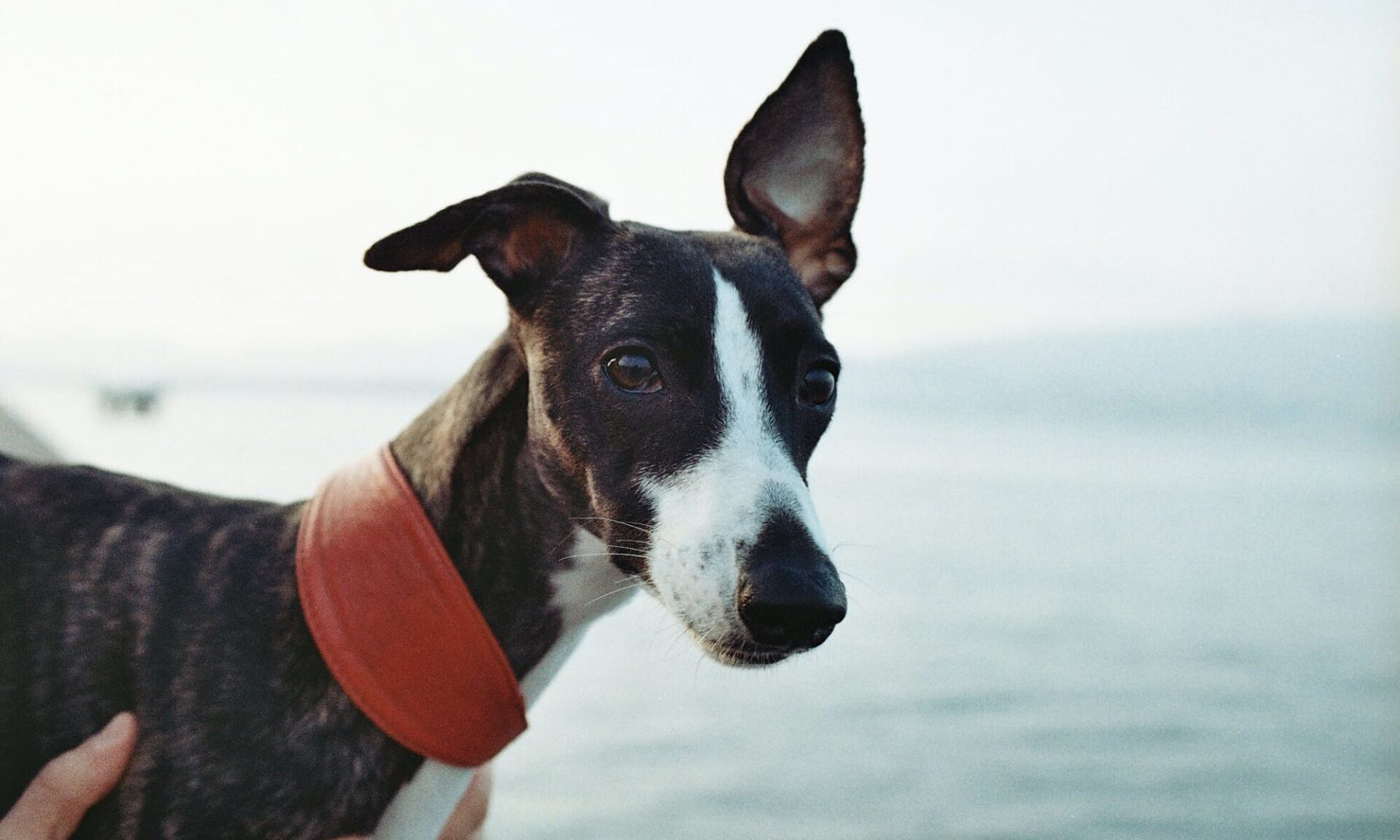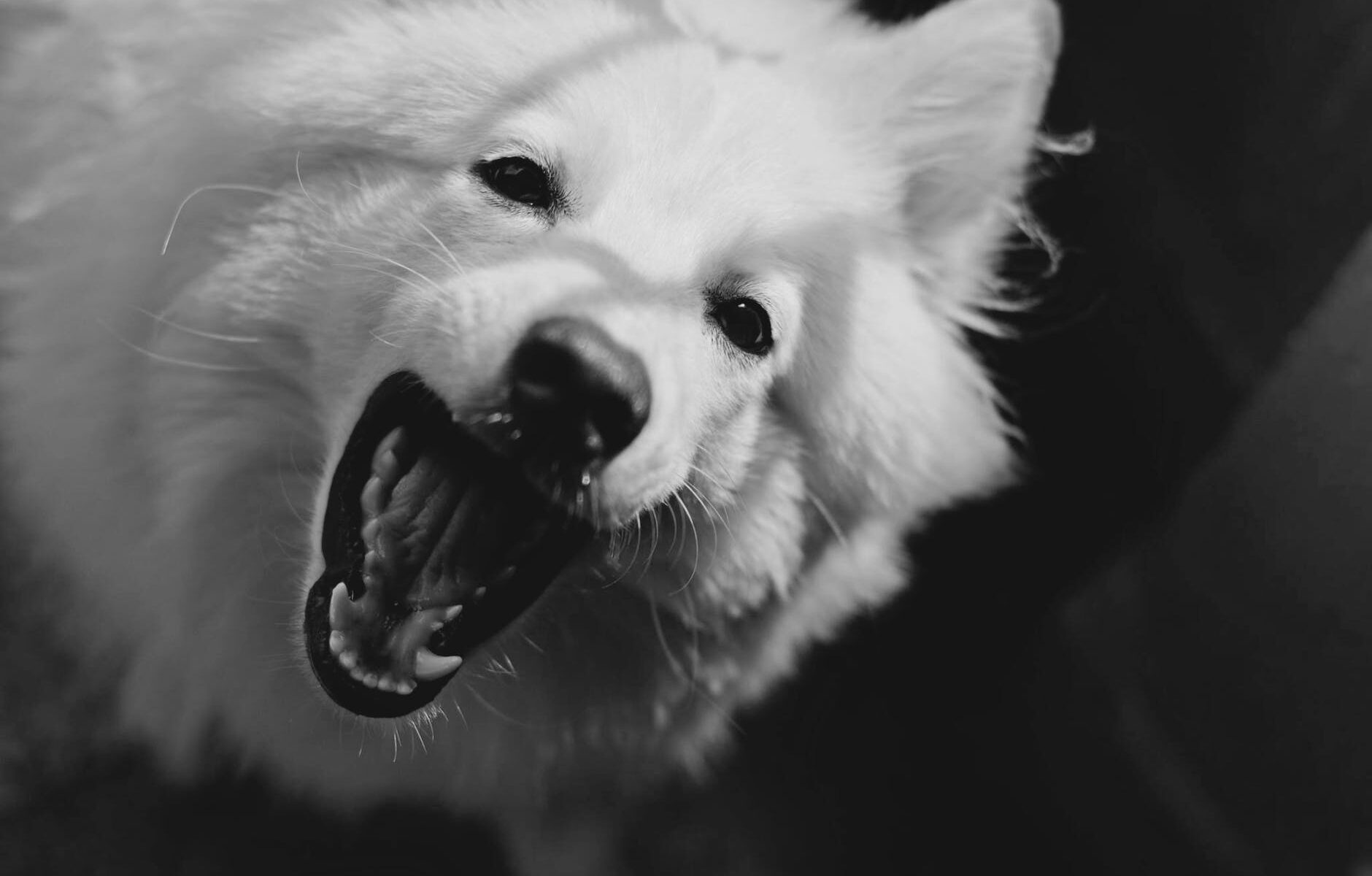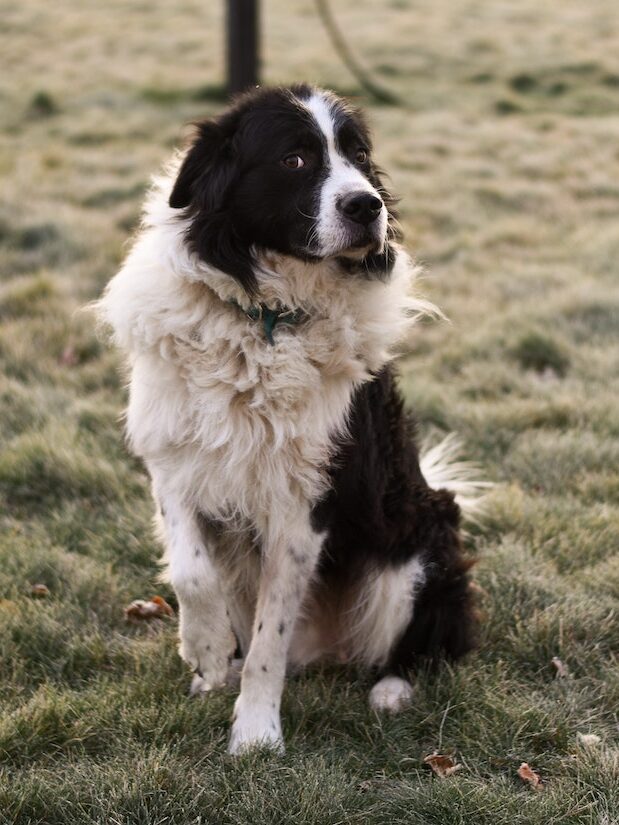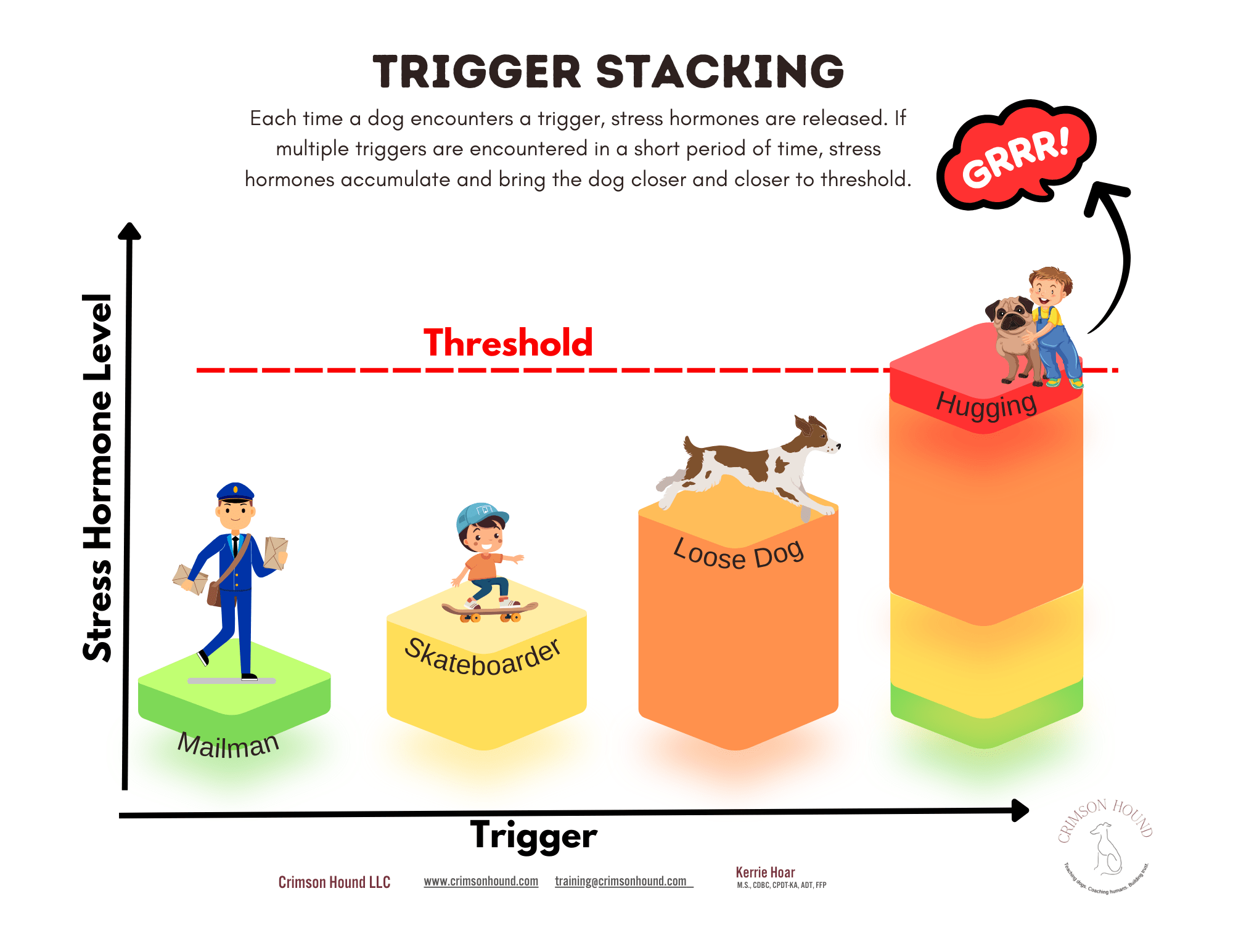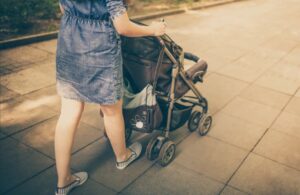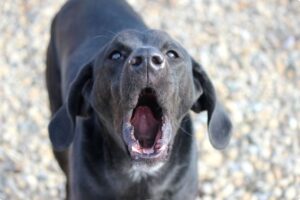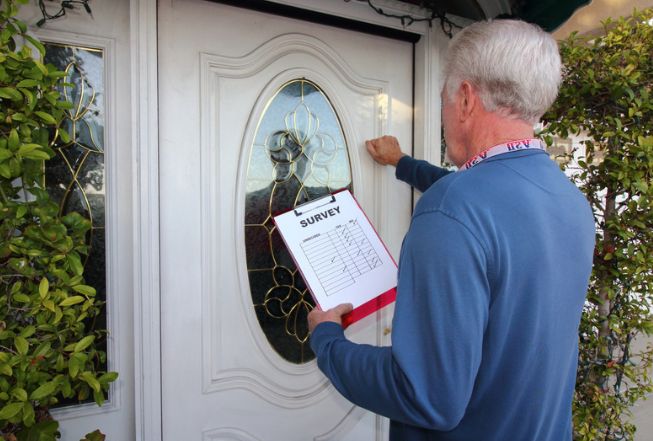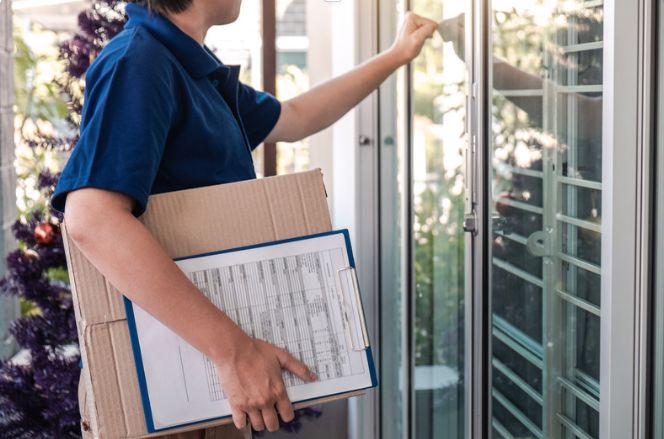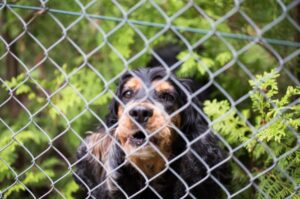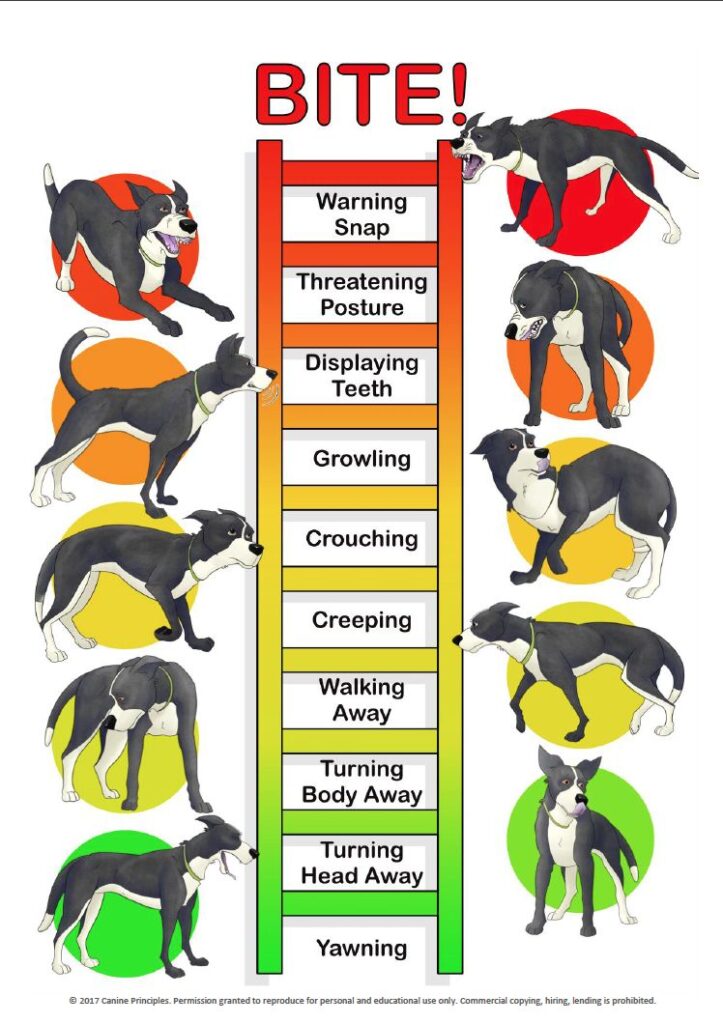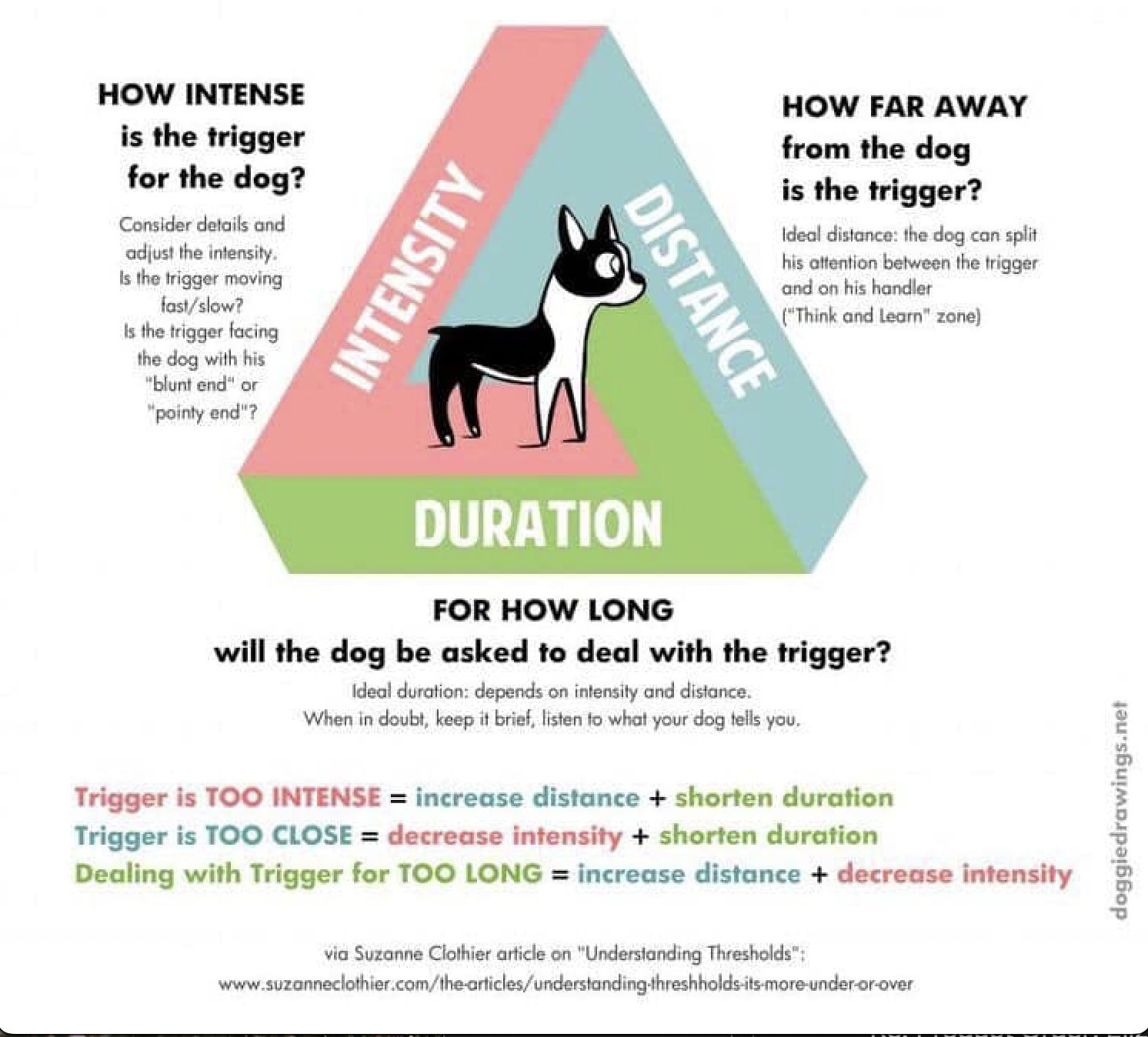Many dogs experience noise phobias – fireworks, thunder, cars backfiring etc. Did you know that more dogs go missing on the 4th of July than any other day of the year? In fact, the busiest day of the year at animal shelters across the country is July 5th. Studies show that upwards of 50% of dogs express fearful behaviors in the face of loud noises. So, what can you do to help your dog navigate storms, city noises and the 4th of July holiday?
Is my dog scared?
Firstly, we need to ask ourselves is this . . . Is my dog scared? Dogs who are afraid or stressed will exhibit some, or all, of the following body language cues:
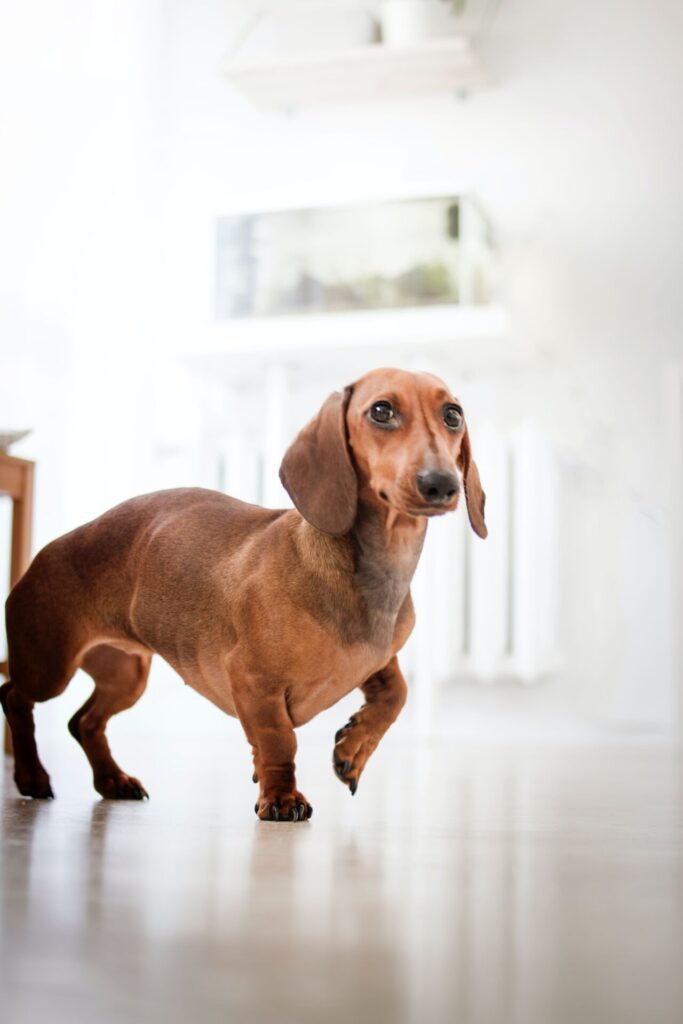
- Pinned back ears
- Crouching or hiding
- Clinginess
- Trembling or shaking
- Whale eye (whites of the eyes are showing)
- Whining or barking
- Pacing
- Panting
- Yawning
- Lip or nose licking
- Drooling
- Urinating or defecating
- Vomiting
Why is my dog afraid of loud noises (AKA noise phobia)?
The first thing to consider is that so many more individuals than just your scared pup are sensitive to loud noises such as fireworks and thunder . . . combat veterans, babies, autistic children, dogs, cats, guinea pigs, rabbits, horses, sheep, zoo animals, birds and other wildlife . . . all experience noise phobia
We all have a startle reflex that is activated by loud noises. Some of us have nervous systems that are more sensitive to these types of stimuli. But if we know what is making that noise or it is expected, we can often regulate our reaction. But, dogs don’t have a gmail calendar or a weather app, so these phenomenon can take them by surprise and trigger their “fight or flight’ response.
Any type of past trauma associated with loud noises (e.g., your puppy was scared by his first fireworks experience, a veteran who experienced combat, etc.) will add to the severity of the noise phobia reaction. In some cases, something as simple as an oven timer, a smoke alarm, a single firecracker bang or a dropped pan can send an individual into a panic attack – so imagine how a full 4th of July fireworks display is going to affect them.
Some breeds, like the herding and gun dog breeds, are predisposed to noise phobias.
Research is showing a link between chronic pain and noise phobia. e.g., Your dog has arthritis in her neck and is napping when a loud noise startles her. She jumps and twists her neck, causing pain to shoot up through her head. She may now fiind that noise (or type of noise) scary since she associates it with pain. If your dog has noise phobia, a first step is a trip to the veterinarian for a thorough examination.
Moreover, dogs and other animals find loud noises to not only be aversive, but painful as well.
For example, while humans are not able to detect sounds above 20,000Hz, dogs can hear up to 60,000Hz. Some fireworks emit sounds above the level of human hearing, but dogs are able to detect those sounds.
In addition, we must consider the effect of trigger stacking on our dogs during the week leading up to the 4th of July. Trigger stacking is a phenomenon where a combination of multiple stressors, some might be quiet minor, occur over a short period of time and culminate in an extreme reaction. If your dog is hearing a firework or two a couple of times each day for the week leading up to the 4th of July, he may already be trigger stacked before a single firecracker is lit on July 4th. By the time that the main fireworks display begins, your dog is way beyond his threshold.
Every individual has a threshold beyond which they will have a reaction. Each time an individual encounters a stressor, a certain amount of cortisol (a stress hormone) is released. Different stressors will create different amounts of cortisol in different individuals. If an individual event creates enough cortisol to cross the reactivity threshold, the individual will react. Stressors can also have an additive effect. It takes 5 to 8 hours for cortisol to dissipate from the blood stream. If an additional stressor occurs within that 5-8 hour window, the cortisol that is released from the second event is added to the cortisol still in the system from the first event . . . bringing the total level closer to threshold. So, if we encounter multiple stressors within a short period of time, they will have an additive effect and can cause the individual to go over threshold and have a reaction.
From my Trigger Stacking blog
Microchips and Identification
Most important, be sure that your dog is never without some form of identification. Additionally, check that his name tag has your current contact information. Double check your microchip provider website to be sure that 1) you are listed as your dog’s owner and 2) your contact information is up to date. If your dog (or other pet) is not microchipped, I strongly recommend having that done as soon as possible. Dogs can slip out of their collar/harness if they panic and try to run away. If you dog’s collar is caught on something, the tags can be torn away. Simply put, microchips work!
A study of more than 7,700 stray animals at animal shelters showed that dogs without microchips were returned to their owners 21.9% of the time, whereas microchipped dogs were returned to their owners 52.2% of the time. Cats without microchips were reunited with their owners only 1.8% of the time, whereas microchipped cats went back home 38.5% of the time. (Lord et al, JAVMA, July 15, 2009) For microchipped animals that weren’t returned to their owners, most of the time it was due to incorrect owner information (or no owner information) in the microchip registry database – so don’t forget to register and keep your information updated.
American Veterinary Medical Association
Other collar options are the GPS collars and attachments that allow you to track your dog’s whereabouts. Beware, however, that the cheaper models often do not live up to the range that is advertised. I have seen lost dogs with trackers that were supposed to work within 100 yards that didn’t actually ping the owner’s phone until the dog was less than 20 feet away.
Just in case you need to post lost dog flyers, always have current photos of your dog on hand. Take good shots from multiple angles to include any identifying markings, scars, etc. . . . close-ups and/or full body shots. If you have your dog clipped, have photos with both long coat and short coat – dogs often look very different before and after grooming!
Safe Confinement for Dogs with Noise Phobia
- Double check gates to be sure that they are securely latched BEFORE letting your dog out of the house.
- If you go for a walk, double leash your dog for safety. You can use a double ended leash like the one in the photo, or just use two leashes. Clip one leash to your dog’s harness and one to the collar. If the dog wriggles out of the harness, you still have one leash attached to his collar. NOTE: Attaching both leashes to two spots on the harness (or to the collar) is not proper double leashing. If the dog wriggles out of the harness, you are simply left holding an empty harness as your dog runs off.
- Add a second layer of safety and take your dog out in the yard on a leash or long line. Dogs can be unbelievably agile and athletic fence jumpers when they are in a blind panic.
- Be sure that your doors and windows are secured latched. A window screen is not going to hold a dog who is panicking and trying to escape.
- Don’t leave your dog unattended in your yard – scared dogs may run through invisible fences, break tethers, climb or jump fences or dig their way out of yards.
- Don’t take your noise phobic pup to a fireworks display – leave him safe at home.
- If you are hosting a party at your home, put your pup in his crate, in a locked room for the evening. There is no reason to chance someone leaving a door open or, worse yet, someone spooking your already frightened dog and getting bit or having your dog run away.
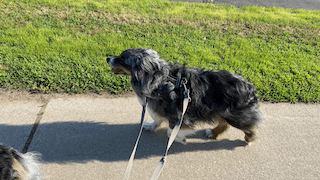
Safe Space
Your dog may already have a safe space – a spot in the basement, his crate, a particular bed or dog bed, under furniture, in a closet, etc. If not, you can create a safe space. The following are tips on how to create a safe space or enhance your dog’s current space.
Location
Find a quiet location where outside noises will be muffled. A location where you can block the flashes and lights from fireworks explosions is best – e.g., basement, a room/closet with no windows, a room with room darkening curtains, etc. can all be good options. If your dog likes his crate, you can cover it with a blanket that will help dampen sound as well as darken the space.
Be sure that your dog has access to plenty of clean water in his safe space. Panting or drooling will cause a dog with noise phobia to dehydrate quickly.
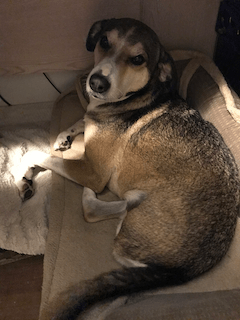
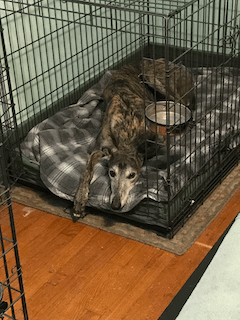
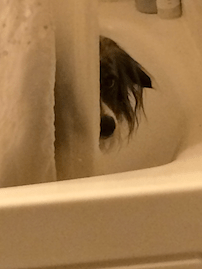
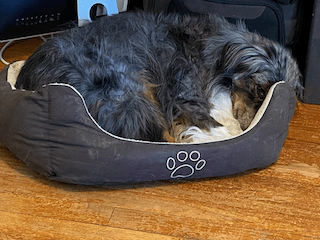
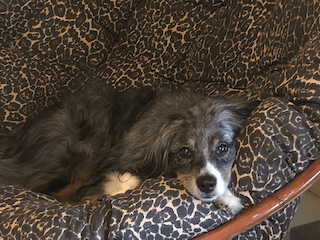
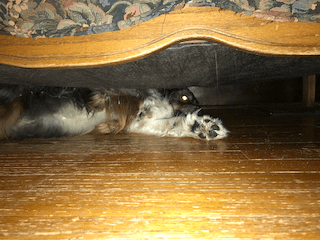
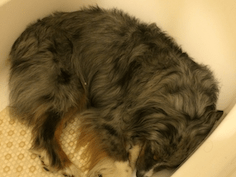
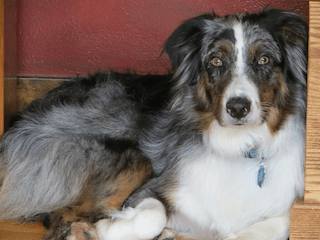
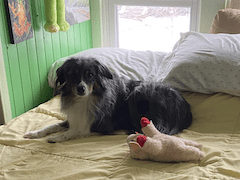
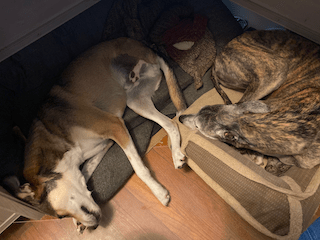
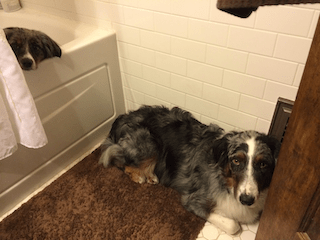
Background Noise
Adding some kind of white noise and/or soothing noise will add to the peaceful atmosphere that you are trying to create for your dog.
- White or brown noise machine or app
- Radio turned to classical, country or reggae music
- Box fan
- Bathroom fan
- Youtube has several tracks with calming music playing in a 8-15 hour loop
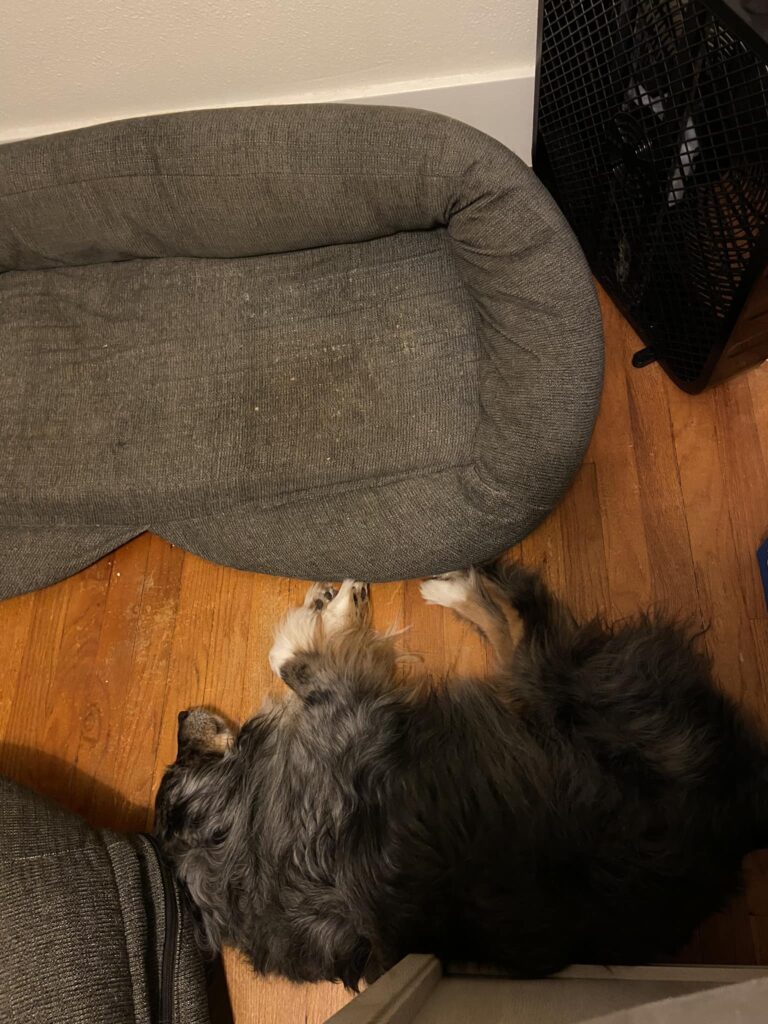
Adding a box fan during a recent fireworks show has made a huge difference for my Australian shepherd. However, every dog is different, the acoustics of every room is different and different noises affect individuals in different ways. Experiment with different methods and use the one that works best for your dog.
When thinking about noise phobia, remembers, there is a difference between sound proofing and sound masking. The concept of sound proofing may not be possible, so think about concentrating your efforts in masking those scary sounds.
Enrichment Activities for Combatting Noise Phobia
Licking, chewing and sniffing are all good calming activites for dogs. Give your dog her favorite type of chew, a stuffed Kong or Topple type of toy or some type of licki mat activity.
Sometimes redirecting nervous energy into play can help. Does your dog enjoy wrestling with you, a good game of tug or fetch? Give it a try and see if your dog finds it helpful.
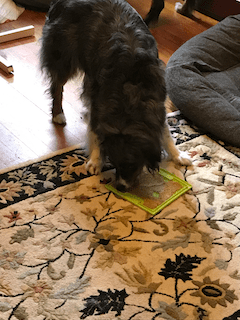
Comfort Items
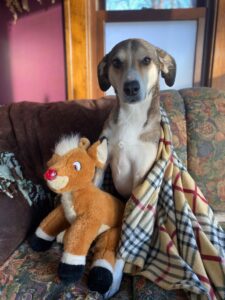
Once you have your dog’s safe space set up, fill it with items that your dog finds comforting. Does your dog have a favorite stuffy or blanket? Add an old t-shirt or sweatshirt that you have been wearing. Your dog will find your scent comforting. Remember, it is always okay to comfort and reassure your dog when he is afraid.
Calming Aids to Help with Noise Phobia
There are a lot of options on the market for calming products:
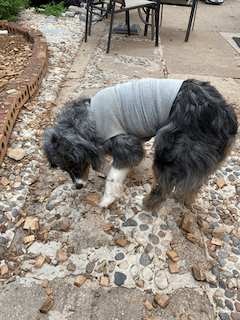
Thundershirts® work on the same principle as swaddling a baby or giving a hug. The pressure causes the release of oxytocin and/or endorphins that have a calming effect for dogs with noise phobias.
You may have heard of Adaptil®. This is a pheromone product that mimics the pheromones produced by nursing mother dogs and have a calming effect on her puppies. Adaptil® comes in wall diffusers, sprays or collar form. It has been shown to have a calming effect on some dogs, so definitely something to try for a dog with noise phobia.
Nutraceuticals
There are many types of nutraceutical products that purport to act as calming agents. A nutraceutical is a supplement or food additive. These products are not regulated by the FDA, so they are a “buyer beware” type of product. You must do your research to determine if the product you have purchased contains the ingredients on the label. They can also be extremely expensive. There is anecdotal evidence that products such as; July 3rd, Rescue Remedy, calming chews, cbd oil, etc., do calm dogs BUT there is little to no scientific evidence to back up these claims. I am not saying that they won’t work for your dog – just be aware.
Pharmaceuticals
The other option, and the one that I would highly recommend looking into TODAY, is some type of pharmaceutical prescribed by your veterinarian. Pharmaceuticals can be used as a situational calming medications that will enable your dog to cope with his noise phobia. There are many different types of situational medications and your vet will help you choose the one that is right for your pet. If you do go this route, be sure that you follow the directions for dosage and administration on the bottle. Some of these drugs need a 1- to 2-hour onboarding window before they will take effect – meaning that if the fireworks show starts at 9pm, you will need to give the medication at 7 or 8pm. Others, however, take effect much faster. The length of effectiveness also varies, so be aware of this so that you are re-dosing properly.
Comforting your Noise Phobic Dog
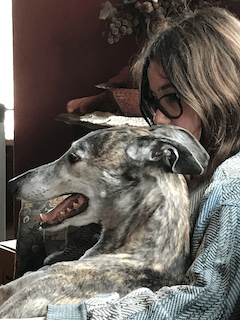
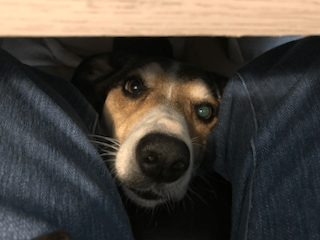
Contrary to what you may have heard or read, you cannot reinforce fear. So, by all means, go ahead and cuddle your dog if he is asking for comfort.
Never punish your dog for being afraid or try to force/flood them into just “getting used to it”.
It is true that you can make your dog more afraid than he already is, by doing something yourself that scares him, by forcing him into situations that scare him already or by being afraid yourself. Emotions are contagious, so if you want your dog to be afraid of thunder, then be afraid yourself! But you’re not going to make him more afraid of storms if you stroke his head and tell him it’s going to be okay.
Dr. Patricia McConnell
Prepping for the 4th of July
- Try to limit stress in the days leading up to the 4th of July. If your dog is already partially trigger stacked, it will be easier to send him over threshold on the 4th.
- If you will be giving medication, be sure that you have your dog’s prescription(s) filled and ready to go.
- Follow the directions to be sure that you are administering any medications or supplements correctly and in a timely fashion. You don’t want to realize 5 minutes before the big fireworks display is set to begin that you should have given your dog his medication 2 hours ago.
- Fill and freeze your enrichment activities ahead of time.
- Make sure that your dog’s safe space is set up and ready to use.
- Take your dog out early in the day for some physical exercise.
- Double leash your dog anytime you are outside your house or fenced yard. You can use two leashes (or a double-ended leash) and hook one leash to your dog’s harness and the other to his collar. That way, if a he hears an early firework and backs out of one, he is still attached to you by the other.
- Make sure to take your pup out for a potty break before fireworks begin as he may not want to go out afterwards.
- For highly fearful dogs who refuse to go outside during the day, you can create a doggie litter box that you can set up in your garage, mudroom or basement.
What about July 5th … and 6th … and 7th …
Where am I going with this? Remember trigger stacking? Well, If your dog was trigger stacked and stressed out in the days leading up to the 4th of July, how do you think he feels in the day or two that follow that big 4th of July fireworks display?!?
Remember, cortisol takes time to clear out of your dog’s system AND additional stressors will have an additive effect on your dog’s blood cortisol levels. Also keep in mind that your neighbors are going to continue to light off a firework or two in the days after the 4th. Each time a firework goes off, or a car backfires, or you drop a book, or there is a thunderstorm, your dog is going to continue to trigger stack. So what . . . well, if you have a reactive dog or a fearful dog, remember that trigger stacking can make all of their behavior issues worse . . . to the point of an increased incidence of aggressive behaviors and bite incidents during this time period. I recommend that you continue to follow the “day of” instructions for the first few days after the 4th. It is better to be safe than sorry.
Training for Next Year: How to Overcome Noise Phobia
What do you need to get started so you are ready for the NEXT 4th of July?
- A recording of fireworks (or other scary sound like thunder, loud trucks, etc) with music and one without
- Plenty of high value treats or high value toy
- Time, Patience and plenty of Enthusiasm
Purchase sound recordings created specifically for desensitizing dogs to noises. iCalmPet has CDs that combine classical music with thunderstorms, fireworks or city sounds. You can find similar tracks on YouTube as well – or you can simply record the sounds yourself.
Training Process
The music and sound tracks are created to present the noises quietly at first, then progress to simulate noises that are closer and closer to you and with smaller and smaller intervals between. The idea is to play these tapes at the easiest level and at a volume low enough that it appears that your dog does not even notice. As you see your dog easily coping at the current level, you are ready to increase volume and/or move to a more difficult track.
This is all that some dogs will need. Many others, however, will need a bit more help making positive associations with loud noises. This is where your recording of just loud noises (no music) will come into play.
Procedure
- Start at a very low volume. We want to start where the dog is just noticing the sound. Play the sound and feed your dog a high value treat or reward with a game of tug, etc. Repeat this several times.
- Let’s put a label on it. You can call the loud noise anything you choose, but I would recommend choosing a label that you will remember to use for every loud noise. For example, if you choose “Boom”, then any and every loud noise is now “Boom”. We are trying to generalize the label to mean that any loud noise is a “Boom” that predicts good stuff.
- Now the steps become: Sound . . . Boom . . . Feed Treat and Celebrate. Repeat this several times.
- Keep treats on you during training so that you are ready if the real deal happens unexpectedly!
- Do several repetitions of Step 3 each day.
- As your dog becomes more comfortable, you can begin to increase the volume of the sound.
- You should also begin to vary the reward and location of the reward.
- The Final Sequence: Noise . . . Boom . . . run to the treat cupboard/refrigerator . . . Feed Treat or Play & Celebrate Enthusiastically.
- Now you are ready for the real thing.
NOTE: Order is important!
Be sure that your dog hears the noise BEFORE you label it and feed treats. If, for example, you see a flash of lightning and begin feeding before you hear the thunder, you risk reversing the association. Instead of seeing noises (thunder) as predicting good things (treats), your dog instead associates treats as predicting scary noises are about to follow.
Teaching positive associations with loud noises is pretty straight forward when it comes to noises like trucks, dropping pots/pans, etc. It is impossible, however, to simulate atmospheric changes and odors that accompany fireworks and thunder. Large fireworks are accompanied by sound, flashes of light and burning smells. Whereas thunder is preceded by changes in barometric pressure and humidity that dogs detect, as well as their keen ability to smell rain and hear thunder long before we are able to do so. This process can take a long time with these types of noises. So, the moral of the story is . . . start today so that you and your dog are ready for NEXT year!
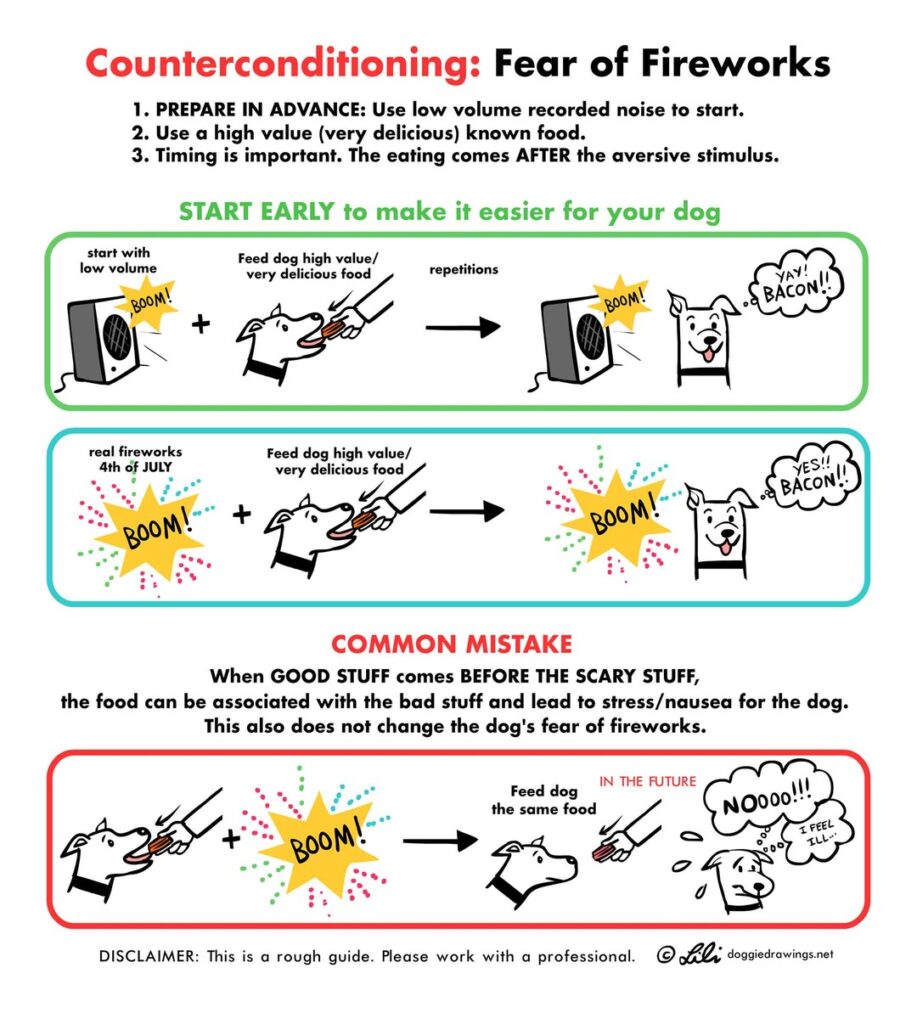
But My Dog is Still Scared
There are times when regardless of how well prepared we think we are, our dog is simply not able to cope with the noise or the vibrations associated with fireworks (and thunderstorms). What can you do?
Well, the first thing you need to do is accept that your dog can’t help that he is fearful. Fear is an emotion and you can’t control emotions. Then you do the best that you can do. See your veterinarian about getting medication. If that medication is not working, don’t be afraid to tell your vet and ask about a different dosage or a different medication altogether. In some cases, consulting with a veterinary behaviorist may be a good option. VBs are veterinarians who have taken advanced work in canine behavior and have additional knowledge in the nuances of behavioral medications. Give yourself some leeway … there are a very limited number of VBs in the U.S. and wait times for an appointment can be months.
Relocate
I am not talking about moving house, but can you plan a dog-friendly vacation to a quiet spot over the 4th of July holiday. Would a simple drive out and away from the epicenter of the noise help your dog with his phobia?
No options? Hunker down with your dog, turn on the fan, turn up the TV, music or white noise machine and wait it out. If you dog prefers to be left alone, that’s okay. If your dog does need comfort, don’t be afraid to comfort him. There is no truth to the myth that comforting your dog just reinforces his behavior. Fear is not a conscious behavior that your dog has chosen to perform. Fear is an emotion that he cannot control. If being comforted makes you feel better when you are afraid, then your dog probably feels the same.
